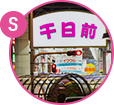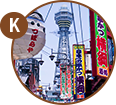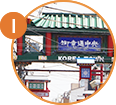
Osaka’s Spring-themed Wagashi BEST 3
2024.03.29


Written by: リナ(rina)
● Find Spring in Wagashi
Spring is here! Here in Japan, spring is when Sakura trees bloom and everyone gets out and enjoys the beautiful Sakura cherry blossoms.
And, in a culture that values seasonal changes in nature, seasonal characteristics are reflected even in what you eat, which means we can find spring in things like desserts, especially in wagashi traditional Japanese sweets. Spring-themed wagashi like Sakura flavored mochi, strawberry daifuku, and fruity monaka wafers makes a great companion for enjoying Osaka’s spring the Japanese way.
Let’s explore the best spring wagashi in Osaka♪
[Ad]
Klook.com
● Sakura Flavored Mochi
Tsuruyahachiman is a long-established fine wagashi shop with over 300 years of history. Their main shop in Osaka is located among office buildings just 2-minute walk from the Midosuji Line’s Yodoyabashi Station. The large signage out front alone shows the long history of this famous wagashi shop.

Inside, the store is spacious with a relaxing cafe space in the back. You can find a variety of sweets, from their signature product, Hyakuraku wafers with azuki bean paste, to colorful dainty pieces of confectionery called jo-namagashi that are often served at tea ceremonies. Any of their products would make a handsome gift.

Our top recommendation at Tsuruyahachiman in spring is Sakuramochi. Sweet pink mochi cake wrapped in a salty preserved Sakura leaf, Sakuramochi is perhaps the top wagashi that represents spring. Wherever you go in Japan, typically, only one Sakura leaf is used in Sakuramochi. At Tsuruyahachiman, the pink mochi is sandwiched between two Sakura leaves. It’s as if the pink mochi is timidly hiding behind the leaves.

I could already smell the gentle aroma of Sakura cherry blossoms as I took one onto my hand♪
Inside the mochi is filled with smooth anko, sweet azuki bean paste. If you’re an anko lover like me, I guarantee you’d love it. The mochi part has a chewy and sticky texture yet has a refined flavor of Sakura. Preserved Sakura leaves are not too salty, making the mild sweetness of the azuki beans more prominent.

Sakuramochi can last 2 days at room temperature. That means you can have this Sakura flavored mochi wrapped in Sakura leaves under the Sakura trees if you’d like!
● Spring Delights from Osome
Going a short distance out of Osaka, located in Asahi Dori Shotengai Shopping Street in Moriguchi City just northeast of Osaka is Osome. Although it’s outside the city, it’s easy to get to Osome. Just take the Osaka Metro Tanimachi Line or Imazatosuji Line to Taishibashi-Imaichi Station, and it’s about a 5-minute walk from there. Simple noren curtains indicating the store name is pretty easy to find.

Opened in 2017, Osome is beloved by the locals. Inside the little shop is casual and comfortable and many kinds of wagashi, including Fruit Daifuku (mochi cake with azuki bean filling and fruits) and ohagi (sweet rice balls with azuki bean filling), are showcased. They all looked great and made my mouth water♪

A favorite at Osome is another spring wagashi, Ichigo Daifuku. Daifuku is a small round mochi stuffed with sweet azuki bean paste. Ichigo Daifuku is a daifuku stuffed with a whole strawberry, right in the middle. Yum! At Osome, you can choose from two types of Ichigo Daifuku, one made with kuroan, regular azuki bean paste, and the other made with shiroan, white bean paste.
I saw the bright red strawberry poking on top of the daifuku♡ The strawberry was so big, it was almost bulging.

Strawberry was juicy and perfectly matched the mild sweetness of anko. Daifuku skin was chewy, yet it melted in my mouth.
It was interesting to compare the two distinct flavors created by two types of beans. The flavor of the strawberry was more prominent with the white beans, while the chunky azuki beans gave the daifuku a nice texture that added to the flavor.
In addition to Ichigo Daifuku, other colorful spring wagashi sold at Osome includes Sakura yokan (jelly like sweet bean snack), tricolor dango (dumplings), Amigasa (aka kusamochi, mochi made with yomogi leaves), Uguisu (made with tender mochi called gyuhi), and Sakuramochi to name a few. Starting at only 110 yen, prices are friendly–or a little dangerous depending on how you look at it; you might end up with too many wagashi! lol

No preservative is used here so you can eat without worry.
Spring wagashi is sold throughout the Sakura season, until around mid-April. Grab your favorites and enjoy them at home or at hanami parties.
● Sakura Shigure - Budding Cherry Blossoms
With 76 years of history, Souke Minamoto Kitchoan operates internationally with locations abroad including the United States and Taiwan and have several locations in Osaka alone. I visited their Koraibashi shop near Kitahama Station on the Sakaisuji Line.
The retro exterior is chic and fits in with the Kitahama neighborhood. Inside the store, I found tasteful wagashi including their popular “nature series” that features the natural appearance, shape, and flavor of fruits.

They also had a host of spring wagashi and all had an appearance and a name that brilliantly depicted the spring season. From top left clockwise: Sakura Goromo (means “court kimono coat in shades of Sakura colors”), Ohka Shigure (Sakura flower rain showers), Sakura Jelly, Hana Murashi (Flowers steamed)

Our top recommendation from these four spring wagashi is…Ohka Shigure!
Shigure is the rain showers seen in late autumn to early winter in Japan. In wagashi, “shigure” is created by coating bean paste with white bean paste that is mixed with egg yolk and rice flour, then steaming it. During the steaming process, the bean paste coating is supposed to crack and these cracks represent shigure, the drizzling rain. The beauty of these cracks is the key to good shigure–those without cracks are considered failed products. Ohka Shigure indeed has cracks and is filled with light pink Sakura flavored bean paste. Topped with a Sakura flower, it looked like a budding Sakura than rain showers to me.


The crumbly shigure and the moist anko paste create a perfect balance of texture while the preserved Sakura flower topping adds saltiness and expands the whole flavor.
This product can last about two weeks. It’d be a good choice for those who want to gift spring-themed wagashi to someone special.
*This information is current as of March 25, 2022. Please understand that some details may have changed.
[Ad]
Klook.com
Spots Introduced
Tsuruyahachiman Osaka Main Store
[Access] About 2 mins walk from Exit 9 at Yodoyabashi Station.
About 4 mins walk from Exit 5-B at Higobashi Station.
[Hours] 8:30 am - 7:00 pm; Saturdays/Sunday/Holidays 8:30 am - 5:00 pm
Osome
[Access] About 3 mins walk from Exit 1 at Taishibashi-Imaichi Station.
[Hours] 11:00 am - 6:00 pm* *Store closes when sold out
[Closed] Tuesdays
Souke Minamoto Kitchoan at Koraibashi
[Access] About 1 mins walk from Exit 6 at Kitahama Station.
[Hours] Monday - Friday 9:00 am – 7:00 pm
Saturdays 10:00 am – 6:00 pm
[Closed] Sundays, Holidays
Recommended Plans

The Best Japanese Breakfast Spots in Osaka
Breakfast is a special time when you’re traveling. At home, you might grab a coffee and a toast …
2025.05.16

Tea Time at A 400-Year-Old Temple♪
Hi! My name is Youn. I'm from South Korea. Temple cafes are becoming a thing in Japan …
2025.05.09

A Cozy Winter Evening at Japan’s Tallest Building
It’s still cold outside and the air is clear, so we took a trip to the top of Abeno Harukas for …
2024.11.29
Yodoyabashi
Higobashi
Taishibashi-Imaichi
Taishibashi-Imaichi
Kitahama



















